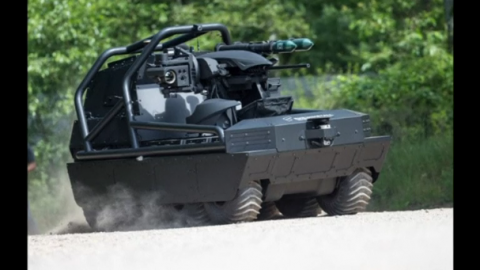
LONDON, United Kingdom (Reuters) — While scientists and campaigners worry about the westernization of robots, the defense industry is showing off the latest autonomous weapons systems at a major arms fair in London.
Among the offerings is an unmanned ground vehicle from German defense manufacturers Rheinmetall, that can operate autonomously and be fitted with its own weapons system.
And while unmanned aerial vehicles, or UAVs, are now commonplace in military arsenals, the unmanned ground vehicle, or UGV, is coming, according to Rheinmetall’s Vice President of Business Development, Alain Tremblay.
“In the mid-90s only half a dozen of nations really used UAVs in the battle space, today everybody is flying different kinds, different models, different size of unmanned air vehicles and the trend on the land domain is becoming very, very serious just like you see a level of semi-autonomous coming in industry and commercial car business and the military is no different,” Tremblay told Reuters.
The Multi Mission Unmanned Ground Vehicle, or MMUGV, is a modular robotic platform designed for military and law enforcement roles.
It can carry a payload of 750 kilograms on land and 300 kg during amphibious operations and with a range extender fitted can keep going for 24 hours.
“We see this as a force multiplier either in a weaponized version, allowing you to bring much heavier weapons up front with the dismounted troops or with a surveillance version providing you a high level of sustained, good quality surveillance, long range, or basically a pure cargo version just to help you carry heavy equipment around the battle space,” Tremblay said.
Earlier this year the Campaign to Stop Killer Robots called for a ban on machines with the ability to attack targets without any human intervention, saying such weapons would breach a moral and ethical boundary.
But according to Tremblay, it is a line that was crossed when drones were armed.
“I don’t think that you’re going to get into a Star Wars game of robots against robots in the battle space but the technology to go there is all there. And that’s the challenge that the military forces are facing with any new technology. How do I take that technology and make it add value to my concept of operation, my modus operandi, and how I want to wage war in the 21st Century? And it’s not an easy answer, not an easy answer whatsoever,” Tremblay said.
The MMUGV base module sells for around 500,000 USD and around 1000 weapons modules have already been sold.
Rapid advancements in technology have allowed countries such as the United States, China, Russia, Israel and Germany to move towards systems that will soon give full combat autonomy to machines, according to a report by Human Rights Watch.







